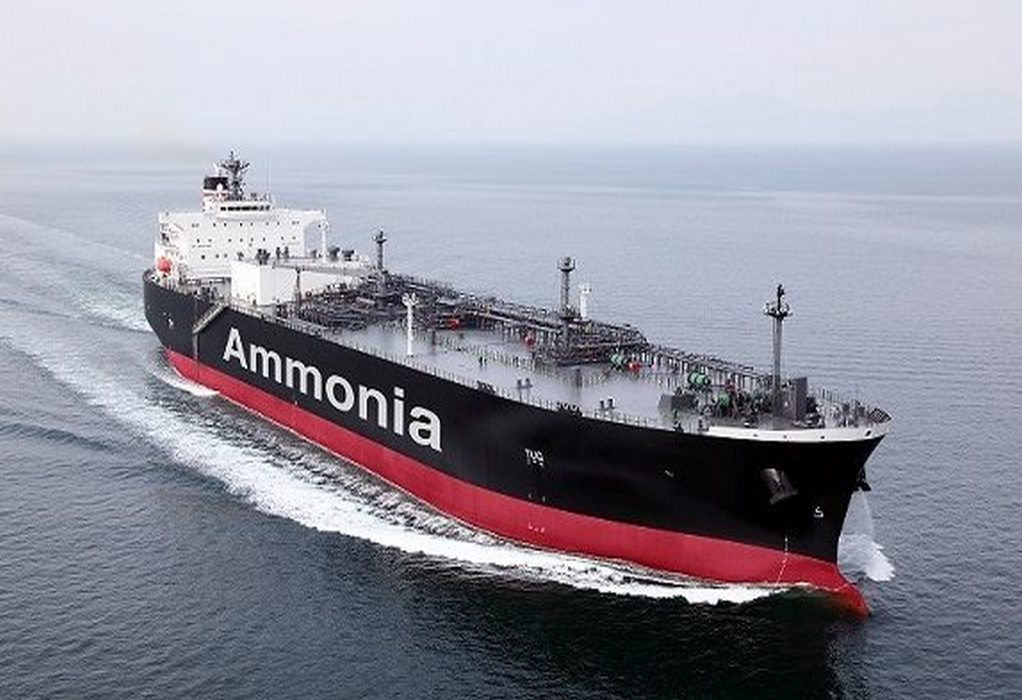Bureau Veritas (BV) presents an assessment with the characteristics of ammonia as a fuel, its advantages as well as the challenges it poses.
As the BV notes, Ammonia is a widely traded chemical commodity that has long been transported in liquefied petroleum gas (LPG) tankers, which are also able to carry ammonia. When produced using renewable energy, ammonia becomes “green ammonia,” a zero-carbon fuel from production to use. This provides shipowners a fuel option that could have no well-to-wake CO2 emissions, which will assist in meeting International Maritime Organization’s (IMO) 2050 emissions reduction targets.
There are several advantages to using ammonia as a marine fuel:
Zero-carbon Ammonia’s key advantage is its status as a zero-carbon fuel when produced renewably, enabling ships to eliminate CO2 emissions.
Availability One of the precursors of the molecule, atmospheric nitrogen (N2), is widely and freely available.
Ammonia storage As a commonly traded commodity, ammonia also benefits from well-developed storage infrastructure and a worldwide terminal network.
Developing technology Internal combustion engines which consume ammonia directly are closer to at-scale development than other solutions for alternative fuels.
However, ammonia also presents challenges: it is toxic at low concentrations, presenting health and safety concerns for crew members. To use ammonia onboard, shipowners must ensure it is handled safely in compliance with applicable requirements. When transported as cargo, ammonia is regulated through the IGC Code. For ships looking to use ammonia as fuel, design requirements can be found in our newly issued NR 671 Rules. The design will have to be assessed through Alternative Design procedure of the IGF Code and SOLAS regulations.
Ammonia safety
Ammonia is highly toxic to both people and marine life, and its powerful smell can be a physical irritant.
Ammonia storage
It has low energy density – about three times less than conventional fuels – requiring greater amounts to be carried onboard and reducing space for other cargo.
Ammonia emissions
In terms of emissions, while ammonia combustion releases no CO2, it may produce nitrous oxide (N2O), a gas 270 times more potent in terms of greenhouse effects than CO2.
Ammonia supply
The supply of green ammonia is currently extremely limited, and competition from other sectors could make this green fuel expensive.
BV adds that there are currently no in-service ships using ammonia as fuel. Ammonia-fueled engines are not yet commercially available, and no existing vessels are equipped for ammonia propulsion. However, two-stroke and four-stroke ammonia fueled engines are under development, as are regulations for handling ammonia as fuel.
Ammonia can be stored under pressure at atmospheric temperature or in a refrigerated state. This means that ships using ammonia as fuel and bunkering vessels may carry different combinations of pressurized, semi-refrigerated or fully refrigerated ammonia. To ensure safe and successful bunkering operations, ships require specific equipment (e.g., compressors, heat exchangers, vapor return systems) and must follow detailed bunkering procedures
Ammonia can be a zero-carbon fuel from a well-to-wake perspective if it is produced from air and water using renewable energy. This is then known as “green ammonia.” Brown ammonia is produced using fossil fuels and is therefore not a zero-carbon fuel from a well-to-wake perspective.
Green ammonia is also known as e-ammonia. It is produced via the Haber-Bosch process, which converts green hydrogen and nitrogen into ammonia. Other methods for producing green ammonia – such as electrochemical nitrogen reduction – are under development, but will take time to mature and become industrialized.
Only green ammonia or e-ammonia can be considered carbon-free. Ammonia produced from fossil fuels in fact has a worse well-to-wake emissions footprint than heavy fuel oil. To truly decarbonize shipping, ammonia must be produced from renewable energy and a low-carbon supply chain.
The BV states that it is unlikely that green ammonia will be ready for use by the time CII compliance is required. For now, short-term measures such as improving energy efficiency or using low-carbon fuels are better solutions. In the long-term, however, green ammonia may be a route to compliance, particularly if IMO regulations evolve to take a well-to-wake approach to emissions.
While fossil fuel-based ammonia is cheap and widely traded, green ammonia is expensive and in short supply. From a production perspective, increasing green ammonia will require the scaling up of renewable energy infrastructure for green hydrogen. From a market perspective, the price of green ammonia will depend on competition from other sectors, making costs hard to predict. Beyond this, shipowners must also factor in the costs of integrating technology onboard and training crew in safe ammonia handling.
Tags: Ammonia, Bureau Veritas (BV), CO2 Emissions, Zero Emission, ZeroCarbon



Recent Posts
Port of Brisbane Unveils Vision 2060 to Drive Smarter, Cleaner, and More Connected Future
Wärtsilä to Deliver Hybrid Propulsion Systems for Vertom Group’s New Low-Emission Vessels
Latvian port receives electric Konecranes Gottwald Mobile Harbor Crane
Sustainable Ocean Economy Vital for Human Development, Says UNDP at UN Ocean Conference
Green Hydrogen Costs in India Could Drop by 40%, Says IEEFA-JMK Report
Cavotec Secures €1.55 Million Shore Power Contract for Port of Antwerp-Bruges
APM Terminals and SANY Marine sign landmark agreement to accelerate decarbonisation
The Port of Gothenburg takes big step towards shore power connection for container and car/RoRo vessels